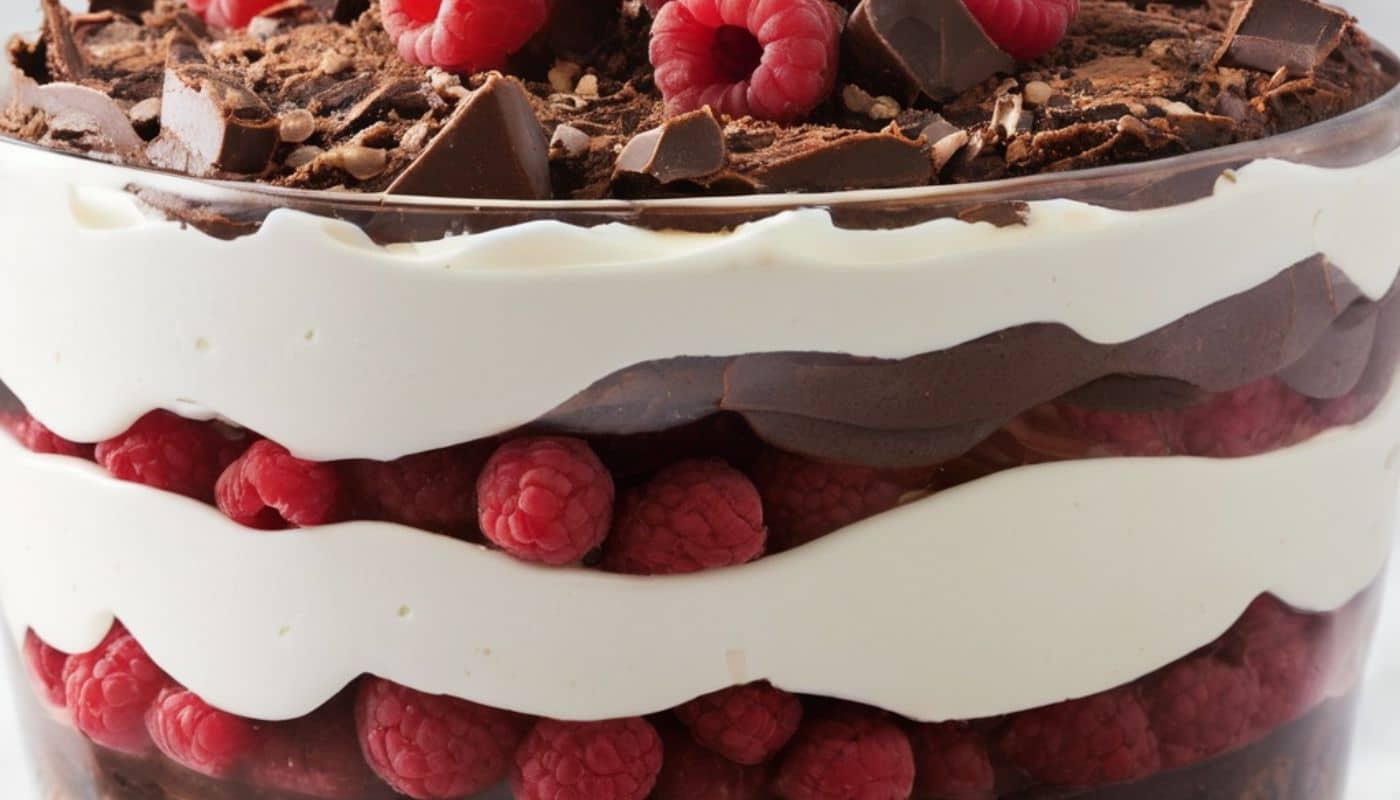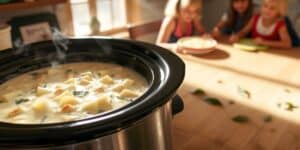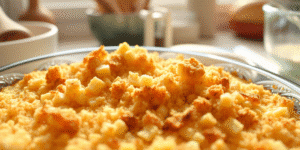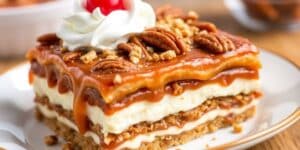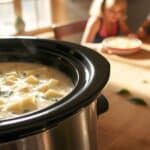There’s something undeniably magic about the combination of dark chocolate, sweet berries, and velvety cream. The Raspberry Fudge Brownie Trifle isn’t just a dessert—it’s a culinary masterpiece that balances textures and flavors in perfect harmony.
As someone who’s crafted thousands of these layered wonders for everything from intimate dinner parties to celebrity weddings, I’m thrilled to share the comprehensive expertise you’ll need to elevate this classic to new heights.
The Evolution of the Trifle
Traditional English trifles date back to the 16th century, originating as a way to use stale cake by soaking it in alcohol and layering it with custard. The modern brownie trifle represents the beautiful evolution of dessert traditions across cultures.
The American brownie—dense, chocolatey, and indulgent—married with the English layering technique creates something greater than either could achieve alone. Its a perfect example of culinary fusion that actually works. When raspberries entered this equation, their tart brightness cutting through the richness, dessert nirvana was achieved.
Why This Combination Works: The Science Behind the Flavors
The magic of this dessert lies in its perfect balance of contrasting elements. Fudgy brownies provide a dense, chocolate foundation with complexity from cocoa’s 600+ flavor compounds. Raspberries contribute brightness through natural acids and aromatics that activate different parts of your palate.
The compounds in chocolate and raspberries are particularly complementary—cocoa’s theobromine and the berries’ anthocyanins create a flavor synergy that’s greater than the sum of its parts. This ain’t just random ingredients thrown together; it’s culinary chemistry at its finest.
Essential Components
The Brownie Base
Let’s be clear: not all brownies are created equal. For trifle purposes, you need a specific texture—fudgy enough to hold up when layered, but not so dense that it becomes impenetrable to the flavors around it. Box mixes simply won’t cut it here.
The perfect trifle brownie contains a higher ratio of chocolate to flour than standard recipes. I recommend using a combination of 70% dark chocolate and dutch-processed cocoa powder for depth. A touch of espresso powder (about 1 teaspoon) amplifies the chocolate without adding coffee flavor—one of those “secret ingredients” professional pastry chefs religiously employ.
For structure, your brownies should include both melted chocolate and cocoa powder. The melted chocolate contributes silky mouthfeel, while cocoa powder provides intensity and helps maintain structure when layered. Unlike stand-alone brownies, slightly underbaking is ideal for trifle brownies—they’ll continue to absorb moisture from surrounding components.
Raspberry Components: Fresh, Sauce, and Liqueur
Raspberries appear in multiple forms throughout a properly constructed trifle. Fresh berries provide bursts of juicy texture and visual appeal, while raspberry sauce or coulis delivers concentrated flavor that permeates the other layers.
For the coulis, I recommend a 2:1 ratio of berries to sugar, cooked briefly and strained to remove seeds. The addition of a tablespoon of raspberry liqueur (Chambord) or framboise eau-de-vie transforms this component from good to extraordinary. The alcohol enhances flavor extraction and provides aromatic complexity that’s immediately noticeable.
When fresh raspberries aren’t in season, frozen berries actually work better for the coulis, as they’re typically harvested at peak ripeness. For the whole berry layers, however, nothing substitutes for fresh—their structural integrity creates textural contrast that’s essential to the experience.
The Creamy Elements: Mascarpone Mousse and Whipped Ganache
Standard trifles often rely on pudding or whipped cream alone. Those components are servicable but lackluster. To create a professional-caliber dessert, we’ll employ two sophisticated cream elements: mascarpone mousse and whipped chocolate ganache.
The mascarpone mousse—a blend of Italian mascarpone cheese, whipped cream, vanilla, and just enough sugar—provides a tangy counterpoint to the sweet elements. It’s stability makes it ideal for layering, and it’s rich mouthfeel bridges the gap between the brownie and fruit components.
For the chocolate element, a whipped ganache outperforms standard chocolate pudding in every way. By whipping cooled ganache (a 2:1 ratio of chocolate to cream) until light and fluffy, you create a mousse-like texture that melts gradually on the palate rather than dissolving instantly like pudding. This controlled melt allows the flavor experience to unfold in stages—critical for a complex dessert.
Assembly Techniques: Building the Perfect Trifle
Layer Sequencing for Maximum Impact
The order of your layers isn’t arbitrary—it’s strategic. Begin with brownies at the base, which provides a stable foundation. Next, brush with a light syrup mixture of raspberry liqueur and simple syrup to ensure moisture and flavor penetration.
The second layer should be raspberry coulis, which will partially absorb into the brownie. Follow with mascarpone mousse, then fresh berries pressed slightly into the mousse. The whipped ganache comes next, followed by another brownie layer. This pattern repeats, creating distinct flavor zones while allowing complementary components to interact.
The Critical Moisture Balance
One of the most common failings in amateur trifles is improper moisture management. Too dry, and the components remain separate instead of melding; too wet, and you’ve created a soggy mess. Finding the perfect balance requires precision and experience.
The brownie layers should be lightly brushed with syrup—just enough to moisten without saturating. About 2 tablespoons per layer is sufficient. The coulis should be thick enough to coat a spoon but thin enough to spread easily. And critically, the creamy elements need the proper stabilization to maintain their structure while still remaining soft.
Chilling Intervals: The Secret Professional Technique
Here’s a technique rarely discussed outside professional kitchens: strategic chilling intervals. Rather than assembling the entire trifle at once, build it in stages with brief chilling periods between layers. This allows each layer to set just enough to support the next without becoming fully firm.
For example, after placing your brownie base and moistening it, chill for 10 minutes before adding coulis. After adding mascarpone, chill for 15 minutes before adding berries. These brief intervals create more distinct layers and prevent components from sinking or bleeding into each other excessively.
Presentation Strategies for Maximum Visual Impact
Vessel Selection
The vessel is as important as the ingredients themselves. Traditional glass trifle bowls with straight sides showcase the layers dramatically, but contemporary rectangular glass containers can create a more modern, architectural presentation.
Individual portions served in clear glasses or jars offer portion control and precise composition. For upscale events, consider custom glass cylinders that can be removed tableside to reveal a perfect free-standing layered dessert—a technique that never fails to impress guests.
Surface Decoration
The top surface presents your greatest creative canvas. Beyond basic whipped cream, consider these professional-level finishes:
- A mirror glaze chocolate disk placed atop the final layer
- Fresh raspberries arranged in concentric circles, glazed with nappage
- Chocolate decorations, such as transfer sheets with geometric patterns
- Edible gold leaf applied sparingly to raspberry tops
- Micro herb garnishes like tiny mint or basil leaves for color contrast
Tempered chocolate decorations elevate the presentation significantly. Simple curved chocolate pieces can be placed vertically along the sides of clear serving vessels, creating dramatic visual interest visible from all angles.
Make-Ahead Strategies and Storage Considerations
Trifles improve with time—up to a point. The ideal resting period allows flavors to meld while maintaining textural integrity. For optimal results, assemble your trifle 8-24 hours before serving.
Storage temperature is crucial. Too cold (below 38°F/3°C), and the fat in your chocolate components will crystallize, creating grainy textures. Too warm, and you’ll lose structural integrity. The ideal holding temperature is 40-42°F (4-5.5°C), slightly warmer than most home refrigerators.
When making ahead for events, consider assembling most components but reserving the final decorative elements until shortly before service. This provides the benefits of flavor melding while maintaining the freshest possible presentation.
Seasonal Variations and Creative Adaptations
While the classic raspberry-chocolate combination is timeless, seasonal adaptations keep this dessert fresh and exciting throughout the year:
Summer Variations
In peak summer, intensify the berry presence by incorporating black raspberries alongside red for color and flavor contrast. Add raspberry powder to the mascarpone for a beautiful pink hue and enhanced berry notes.
Autumn Transformation
For fall, consider a variation using blackberries with hints of warming spices (cinnamon, cardamom) in the brownie base. A splash of bourbon in place of raspberry liqueur creates a sophisticated seasonal adaptation.
Winter Holiday Version
During holiday seasons, incorporate peppermint into the ganache layer and use a combination of raspberries and cranberries for festive color. A light dusting of crushed candy canes on top adds seasonal charm.
Spring Freshness
In spring, brighten the trifle with lemon zest added to the mascarpone and a combination of raspberries and strawberries. Consider an elderflower liqueur in place of the raspberry variety for floral notes.
Troubleshooting Common Challenges
Weeping Layers
If your cream layers begin to separate and release liquid (weeping), you’ve likely overwhipped initially or used dairy with insufficient fat content. Professional solution: incorporate a small amount (1/2 teaspoon per cup) of mascarpone into standard whipped cream to stabilize it naturally.
Brownie Texture Issues
When brownies become too soggy, you’ve either applied too much syrup or built layers too far in advance. Correction: toast brownie cubes briefly in a 300°F (150°C) oven before assembly to create a moisture barrier that slows absorption.
Color Bleeding
Red raspberry juices bleeding into cream layers can look unintentional and messy. Prevention technique: partially freeze fresh berries before assembly, and create a thin barrier layer by dusting each cream layer with cocoa powder before adding berries.
Conclusion
The Raspberry Fudge Brownie Trifle represents dessert at its most sophisticated yet accessible form. By understanding the science behind the components, employing professional assembly techniques, and embracing creative presentation, you transform what could be an ordinary layered dessert into a memorable culinary experience.
Remember that this dessert embodies balance in all things—sweet and tart, light and dense, crisp and soft. Each bite should deliver multiple textural and flavor experiences that evolve as you eat it. Thats what separates a truly great trifle from an average one.
Whether you’re creating this for an intimate dinner or a grand celebration, the principles remain the same: quality ingredients, thoughtful composition, strategic assembly, and beautiful presentation. Master these elements, and you’ll create a dessert experience that lingers in memory long after the last spoonful has been savored.

Emily Rose Johnson is a talented writer known for her captivating storytelling and evocative prose, creating unforgettable characters and compelling narratives in various genres.
